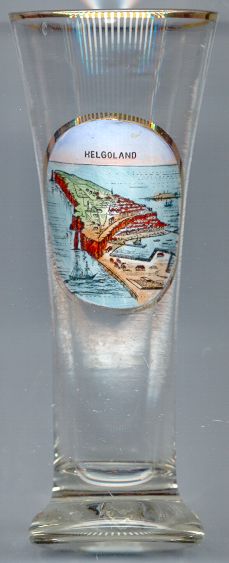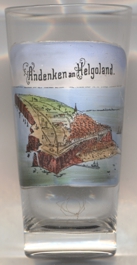

|
| DEUTSCHLAND | GERMANY |
| Bundesland: Schleswig-Holstein | |
| Kreis: Pinneberg |
 The island of Helgoland (English: Heligoland; Frisian: Deät Lun or Hålilönj) is located approximately 50 m off the
German mainland in the German Bight and is Germany's only open sea island.
The famous sandstone rock island covers an area of 1 km², the steep cliffs reach a height of 61 m. The main, upper part of the island can only
be reached from the lower parts by three flights of stairs (with 182 to 250 steps) and one elevator. Until the night of New Years Eve 1720/21, the smaller
island Düne ('dune', today 0.7 km²) was connected to the main island.
The island of Helgoland (English: Heligoland; Frisian: Deät Lun or Hålilönj) is located approximately 50 m off the
German mainland in the German Bight and is Germany's only open sea island.
The famous sandstone rock island covers an area of 1 km², the steep cliffs reach a height of 61 m. The main, upper part of the island can only
be reached from the lower parts by three flights of stairs (with 182 to 250 steps) and one elevator. Until the night of New Years Eve 1720/21, the smaller
island Düne ('dune', today 0.7 km²) was connected to the main island.
 For centuries, the inhabitants of Helgoland worked as fishermen. At times, Helgoland also was home of pirates. The infamous Klaus Störtebecker operated from
Helgoland from about 1394 until his capture in 1401. The people of Helgoland began to work as nautical pilots in 1655. They obtained a privilege for
the waters around Helgoland and soon had a monopole within the German Bight.
When in 1713/1721 the duchy of Schleswig-Holstein-Gottorf had to give up its Schleswig possessions after the Great Northern War of 1700–1721, Helgoland
became part of the duchy of Schleswig which then belonged to the Danish Crown.
The island was conquered by England in 1807 and was used to operate
against the continental blockade of Napoleon. The tradition of Helgoland as a seaside resort began already in 1826.
The acquisition of the island became of great importance for the German Empire in the late 19th century because a presence of English troops
in the German Bight would have jeopardised the strategic use of the Kaiser-Wilhelm-Kanal (today Nord-Ostsee-Kanal, Kiel canal)
which was built in 1887–1895. The Heligoland-Zanzibar Treaty finally secured the island for Germany and
on 10 August 1890 Helgoland became part of the German Empire.
During World War II, all inhabitants of Helgoland were evacuated and were replaced by 4,000 navy soldiers.
A plan of the Nazis to build a large sea port was never completed; only Düne island was enlarged. In 1945, Helgoland was completely destroyed by an
English air raid. In 1947, the English attempted to blow up the extensive bunkers and tunnels. However, only parts of the southern tip of the island collapsed.
The occupation ended in 1952. Since then, Helgoland has regained its position as one of Germany's most popular seaside spas.
For centuries, the inhabitants of Helgoland worked as fishermen. At times, Helgoland also was home of pirates. The infamous Klaus Störtebecker operated from
Helgoland from about 1394 until his capture in 1401. The people of Helgoland began to work as nautical pilots in 1655. They obtained a privilege for
the waters around Helgoland and soon had a monopole within the German Bight.
When in 1713/1721 the duchy of Schleswig-Holstein-Gottorf had to give up its Schleswig possessions after the Great Northern War of 1700–1721, Helgoland
became part of the duchy of Schleswig which then belonged to the Danish Crown.
The island was conquered by England in 1807 and was used to operate
against the continental blockade of Napoleon. The tradition of Helgoland as a seaside resort began already in 1826.
The acquisition of the island became of great importance for the German Empire in the late 19th century because a presence of English troops
in the German Bight would have jeopardised the strategic use of the Kaiser-Wilhelm-Kanal (today Nord-Ostsee-Kanal, Kiel canal)
which was built in 1887–1895. The Heligoland-Zanzibar Treaty finally secured the island for Germany and
on 10 August 1890 Helgoland became part of the German Empire.
During World War II, all inhabitants of Helgoland were evacuated and were replaced by 4,000 navy soldiers.
A plan of the Nazis to build a large sea port was never completed; only Düne island was enlarged. In 1945, Helgoland was completely destroyed by an
English air raid. In 1947, the English attempted to blow up the extensive bunkers and tunnels. However, only parts of the southern tip of the island collapsed.
The occupation ended in 1952. Since then, Helgoland has regained its position as one of Germany's most popular seaside spas.
![[scale]](lineal.jpg)